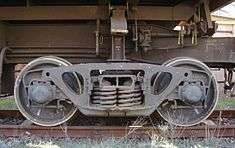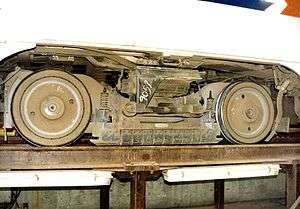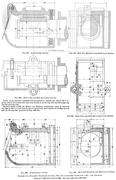Bogie

A bogie (/ˈboʊɡi/ BOH-ghee) (in some senses called a truck in North American English) is a chassis or framework carrying wheels, attached to a vehicle, thus serving as a modular subassembly of wheels and axles. Bogies take various forms in various modes of transport. A bogie may remain normally attached (as on a railway carriage [car] or locomotive, or on a semi-trailer) or be quickly detachable (as the dolly in a road train); it may contain a suspension within it (as most rail and trucking bogies do), or be solid and in turn be suspended (as most bogies of tracked vehicles are); it may be mounted on a swivel, as traditionally on a railway carriage or locomotive, additionally jointed and sprung (as in the landing gear of an airliner), or held in place by other means (centreless bogies).
While bogie is the preferred spelling and first-listed variant in various dictionaries,[2][3][4] bogey and bogy are also used.[2][3]
Railway
A bogie in the UK, or a railroad truck, wheel truck, or simply truck in North America, is a structure underneath a train to which axles (and, hence, wheels) are attached through bearings. In Indian English, bogie may also refer to an entire railway carriage.[5]
The first standard gauge British railway to build coaches with bogies, instead of rigidly mounted axles, was the Midland Railway in 1874.[6]
Bogies serve a number of purposes:[7]
- Support of the rail vehicle body
- Stability on both straight and curved track
- Improve ride quality by absorbing vibration and minimizing the impact of centrifugal forces when the train runs on curves at high speed
- Minimizing generation of track irregularities and rail abrasion
Usually, two bogies are fitted to each carriage, wagon or locomotive, one at each end. An alternate configuration often is used in articulated vehicles, which places the bogies (often Jacobs bogies) under the connection between the carriages or wagons.
Most bogies have two axles,[7] but some cars designed for heavy loads have more axles per bogie. Heavy-duty cars may have more than two bogies using span bolsters to equalize the load and connect the bogies to the cars.
Usually, the train floor is at a level above the bogies, but the floor of the car may be lower between bogies, such as for a bilevel rail car to increase interior space while staying within height restrictions, or in easy-access, stepless-entry, low-floor trains.
Key components of a bogie include:[7]
- The bogie frame: This can be of inside frame type where the main frame and bearings are between the wheels, or (more commonly) of outside frame type where the main frame and bearings are outside the wheels.
- Suspension to absorb shocks between the bogie frame and the rail vehicle body: Common types are coil springs, or rubber airbags.
- At least one wheelset, composed of an axle with bearings and a wheel at each end
- Axle box suspensions absorb shocks between the axle bearings and the bogie frame. The axle box suspension usually consists of a spring between the bogie frame and axle bearings to permit up-and-down movement, and sliders to prevent lateral movement. A more modern design uses solid rubber springs.
- Brake equipment: Two main types are used: brake shoes that are pressed against the tread of the wheel, and disc brakes and pads.
- In powered vehicles, some form of transmission, usually electrically powered traction motors or a hydraulically powered torque converter
The connections of the bogie with the rail vehicle allow a certain degree of rotational movement around a vertical axis pivot (bolster), with side bearers preventing excessive movement. More modern, bolsterless bogie designs omit these features, instead taking advantage of the sideways movement of the suspension to permit rotational movement.[7]
Articulated bogie
An articulated bogie is any one of a number of bogie designs that allow railway equipment to safely turn sharp corners, while reducing or eliminating the screeching normally associated with metal wheels rounding a bend in the rails. There are a number of such designs, and the term is also applied to train sets that incorporate articulation in the vehicle, as rather than he bogies themselves.
Examples
Commonwealth bogie

The Commonwealth bogie, manufactured by the English Steel Corporation under licence from the Commonwealth Steel Company in Illinois, USA. Fitted with SKF or Timken bearings, it was introduced in the late 1950s for all BR Mark 1 vehicles. It was a heavy, cast-steel design weighing about 6.5 long tons (6.6 t),[8] with sealed roller bearings on the axle ends, avoiding the need to maintain axle box oil levels.
The leaf springs were replaced by coil springs (one per wheel) running vertically rather than horizontally. The advanced design gave a better ride quality than the BR1, being rated for 100 miles per hour (160 km/h).
The side frame of the bogie was usually of bar construction, with simple horn guides attached, allowing the axle boxes vertical movements between them. The axle boxes had a cast-steel equaliser beam or bar resting on them. The bar had two steel coil springs placed on it and the bogie frame rested on the springs. The effect was to allow the bar to act as a compensating lever between the two axles and to use both springs to soften shocks from either axle. The bogie had a conventional bolster suspension with swing links carrying a spring plank.
B4 bogie
The B4 bogie was introduced in 1963. It was a fabricated steel design versus cast iron and was lighter than the Commonwealth, weighing in at 5 long tons (5.08 t; 5.60 short tons).[9] It also had a speed rating of 100 miles per hour (160 km/h).
Axle to spring connection was again with fitted roller bearings. However, now two coil springs rather than one were fitted per wheel.[10]
Only a very small number of Mark 1 stock was fitted with the B4 bogie from new, it being used on the Mark 1 only to replace worn BR1 bogies. The British Rail Mark 2 coach, however, carried the B4 bogies from new. A heavier-duty version, the B5, was standard on Southern Region Mk1-based EMUs from the 1960s onwards. Some Mark 1 catering cars had mixed bogies—a B5 under the kitchen end, and a B4 under the seating end. Some of the B4-fitted Mark 2s, as well as many B4-fitted Mark 1 BGs were allowed to run at 110 miles per hour (180 km/h) with extra maintenance, particularly of the wheel profile, and more frequent exams.
BT10 bogie
The BT10 bogie was introduced on the British Rail Mark 3 coach in the 1970s. Each wheel is separately connected to the bogie by a swing-arm axle.
There is dual suspension:
- Primary suspension via a coil spring and damper mounted on each axle
- Secondary suspension via two air springs mounted on the pivot plank, this is connected to the bogie by pendulum links. A constant coach height is maintained by air valves.[11]
Locomotives
Diesel and electric
Most diesel locomotives and electric locomotives are carried on bogies. Those used in the USA include AAR type A switcher truck, Blomberg B, HT-C truck and Flexicoil.[12]
Steam
On a steam locomotive, the leading and trailing wheels may be mounted on bogies like pony trucks or Bissel bogies. Articulated locomotives (e.g. Fairlie, Garratt or Mallet locomotives) have power bogies similar to those on diesel and electric locomotives.
Tramway
Modern

Tram bogies are much simpler in design because of their axle load, and the tighter curves found on tramways mean tram bogies almost never have more than two axles. Furthermore, some tramways have steeper gradients and vertical, as well as horizontal, curves, which means tram bogies often need to pivot on the horizontal axis, as well.
Some articulated trams have bogies located under articulations, a setup referred to as a Jacobs bogie. Often, low-floor trams are fitted with nonpivoting bogies and many tramway enthusiasts see this as a retrograde step, as it leads to more wear of both track and wheels and also significantly reduces the speed at which a tram can round a curve.[13]
Historic
In the past, many different types of bogie (truck) have been used under tramcars (e.g. Brill, Peckham, maximum traction). A maximum traction truck has one driving axle with large wheels and one nondriving axle with smaller wheels. The bogie pivot is located off-centre, so more than half the weight rests on the driving axle.

Hybrid systems

The retractable stadium roof on Toronto's Rogers Centre used modified off-the-shelf train bogies on a circular rail. The system was chosen for its proven reliability.
Rubber-tyred metro trains use a specialised version of railway bogies. Special flanged steel wheels are behind the rubber-tired running wheels, with additional horizontal guide wheels in front of and behind the running wheels, as well. The unusually large flanges on the steel wheels guide the bogie through standard railroad switches, and in addition keep the train from derailing in case the tires deflate.
Variable gauge axles
To overcome breaks of gauge some bogies are being fitted with variable gauge axles (VGA) so that they can operate on two different gauges. These include the SUW 2000 system from ZNTK Poznań.
Cleminson system
The Cleminson system is not a true bogie, but serves a similar purpose. It was based on a patent of 1883 by James Cleminson,[14] and was once popular on narrow-gauge rolling stock, e.g. on the Isle of Man and Manx Northern Railways. The vehicle would have three axles and the outer two could pivot to adapt to curvature of the track. The pivoting was controlled by levers attached to the third (centre) axle, which could slide sideways.[15]
Tracked vehicles
Some tanks and other tracked vehicles have bogies as external suspension components (see armoured fighting vehicle suspension). This type of bogie usually has two or more road wheels and some type of sprung suspension to smooth the ride across rough terrain. Bogie suspensions keep much of their components on the outside of the vehicle, saving internal space. Although vulnerable to antitank fire, they can often be repaired or replaced in the field.
Articulated lorries (tractor-trailers)
In trucking, a bogie is the subassembly of axles and wheels that supports a semi-trailer, whether permanently attached to the frame (as on a single trailer) or making up the dolly that can be hitched and unhitched as needed when hitching up a second or third semi-trailer (as when pulling doubles or triples).
Image gallery
-

A journal box.[1] Journal boxes are no longer used on North American railways.[2][3]
-

A US-style railroad truck with journal bearings in journal boxes[2][3]
-
Bettendorf-style freight car truck. This one uses journal bearings in journal boxes.[2][3]
-
Archbar type truck with journal bearings in journal boxes as used on some steam locomotive tenders. A version of the archbar truck was at one time also used on US freight cars.
-

Anheuser-Busch refrigerated rail car on archbar freight trucks
-

Japanese archbar truck with axleboxes
- ^ "Railroad Dictionary: J". CSX.com. CSX Corporation. 2012. Retrieved 15 November 2014.
- ^ a b c "AAR M-1003 Certified Truck Component Manufacturing". ColumbusCastings.com. Columbus, Ohio: Columbus Castings. Retrieved 19 November 2014.
- ^ a b c "General Information" (PDF). SCTCO.com. Standard Car Truck Company. January 2000. Retrieved 19 November 2014.
|section=ignored (help)
See also
Articles on bogies and trucks
Related topics
References
- ↑ http://www.google.com/patents/US1924237 patents/US1924237
- 1 2 Merriam-Webster, Merriam-Webster's Collegiate Dictionary, Merriam-Webster.
- 1 2 Houghton Mifflin Harcourt, American Heritage Dictionary of the English Language (5th ed.), Houghton Mifflin Harcourt.
- ↑ Oxford Dictionaries Online, Oxford Dictionaries Online, Oxford University Press.
- ↑ http://www.oxfordadvancedlearnersdictionary.com/dictionary/bogie
- ↑ Jenkinson, David (1988). British Railway Carriages of the 20th Century - Volume 1: The end of an era, 1901-22. London: Guild Publishing. p. 10. CN 8130.
- 1 2 3 4 Isao Okamoto (December 1998). "How Bogies Work" (PDF). Japan Railway & Transport Review (18): 52–61.
- ↑ Parkin, Keith (1991). British Railways Mark 1 Coaches. Penryn: Pendragon. p. 35. ISBN 0-906899-49-4.
- ↑ Parkin 1991, p. 37
- ↑ Unofficial West Somerset Railway website - Bogies
- ↑ Roger Barnett - British Rail’s InterCity 125 and 225
- ↑ http://www.hosam.com/emd/emd6a.html
- ↑ "ČVUT.cz - Čapek, Kolář" (PDF). Retrieved 2010-05-12.
- ↑ http://www.icevirtuallibrary.com/docserver/fulltext/imotp.1897.19461.pdf?expires=1315520526&id=id&accname=guest&checksum=AD521ED02561C3CF38D1772ECF1ACA2B
- ↑ http://www.festipedia.org.uk/wiki/Cleminson_Flexible_Six-Wheeled_Waggon
Further reading
- Baur, Karl Gerhard (2006). Drehgestelle - Bogies. Freiburg i.B.: EK-Verlag. ISBN 978-3-88255-147-1. (German) (English)
External links
| Wikimedia Commons has media related to Rolling stock bogies. |
-
 The dictionary definition of bogie at Wiktionary
The dictionary definition of bogie at Wiktionary -
 "Bogie". Encyclopædia Britannica. 4 (11th ed.). 1911.
"Bogie". Encyclopædia Britannica. 4 (11th ed.). 1911. - Truck (bogie) with tyres
- Track modelling

